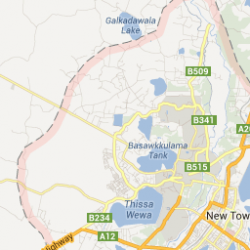Difference between revisions of "Thammannakulama"
(Created page with "thumb|250px| '''Thammannakulama''' or '''Thammannkulam''' located in Anuradhapura, Sri Lanka. It is the Largest Town in the Anuradhapura City. Anu...") |
|||
| Line 1: | Line 1: | ||
[[File:Anuradapura_map.png|thumb|250px|]] | [[File:Anuradapura_map.png|thumb|250px|]] | ||
| − | '''Thammannakulama''' or '''Thammannkulam''' located in Anuradhapura, Sri Lanka. It is the Largest Town in the Anuradhapura City. Anuradhapura Airport located near Thammannakulama. And Also Nuwara Wewa situated middle of the Thammannakulama. Morden Anuradhapura City was created by people of Thammannakulama, and it is Buddhist Town. | + | '''[[Thammannakulama]]''' or '''Thammannkulam''' located in [[Anuradhapura]], [[Sri Lanka]]. It is the Largest Town in the [[Anuradhapura]] City. [[Anuradhapura]] Airport located near [[Thammannakulama]]. And Also Nuwara Wewa situated middle of the [[Thammannakulama]]. Morden [[Anuradhapura]] City was created by [[people]] of [[Thammannakulama]], and it is [[Buddhist]] Town. |
| − | ==Ancient City== | + | ==[[Ancient]] City== |
| − | As Heart of Anuradhapura, Thammannakulama attained its highest magnificence about the commencement of the Christian era. In its prime it ranked beside Nineveh and Babylon in its colossal proportions—its four walls, each 16 miles (26 km) long, enclosing an area of 256 square miles (663 km²) —in the number of its inhabitants, and the splendour of its shrines and public edifices. The city also had some of the most complex irrigation systems of the ancient world, situated in the dry zone of the country the administration built many tanks to irrigate the land. Most of these tanks still survive. To date, it is believed that some of these tanks are the oldest surviving reservoirs in the world today. | + | As [[Heart]] of [[Anuradhapura]], [[Thammannakulama]] [[attained]] its [[highest]] magnificence about the commencement of the [[Christian]] {{Wiki|era}}. In its prime it ranked beside Nineveh and {{Wiki|Babylon}} in its colossal proportions—its four walls, each 16 {{Wiki|miles}} (26 km) long, enclosing an area of 256 square {{Wiki|miles}} (663 km²) —in the number of its inhabitants, and the [[splendour]] of its [[shrines]] and public edifices. The city also had some of the most complex irrigation systems of the [[ancient]] [[world]], situated in the dry zone of the country the administration built many tanks to irrigate the land. Most of these tanks still survive. To date, it is believed that some of these tanks are the oldest surviving reservoirs in the [[world]] today. |
==Growth of City== | ==Growth of City== | ||
| − | The city's popularity grew both as a ritual centre and as the administrative centre, a large population was attracted to the city for permanent settlement. Thus the living facilities were improved to accommodate the expanding population. King Vasabha constructed many ponds which were fed by a network of subterranean channels which were constructed to supply water to the city. Tissa and Abhayavapi tanks were built, the Nuwara weva was built and the Malwatu Oya was dammed to build the Nachchaduwa wewa which was 4408 acres (17.84 km²) in size. | + | The city's [[popularity]] grew both as a [[ritual]] centre and as the administrative centre, a large population was attracted to the city for [[permanent]] settlement. Thus the living facilities were improved to accommodate the expanding population. [[King]] [[Vasabha]] [[constructed]] many ponds which were fed by a network of subterranean [[channels]] which were [[constructed]] to supply [[water]] to the city. [[Tissa]] and [[Abhayavapi]] tanks were built, the Nuwara weva was built and the Malwatu Oya was dammed [[to build]] the Nachchaduwa wewa which was 4408 acres (17.84 km²) in size. |
| − | ==Notable people== | + | ==Notable [[people]]== |
| − | ::*King Ravana | + | ::*[[King]] [[Ravana]] |
| − | ::*King Buddhadasa | + | ::*[[King]] [[Buddhadasa]] |
{{W}} | {{W}} | ||
[[Category:Buddhist Pilgrimages]] | [[Category:Buddhist Pilgrimages]] | ||
Latest revision as of 18:11, 4 February 2016
Thammannakulama or Thammannkulam located in Anuradhapura, Sri Lanka. It is the Largest Town in the Anuradhapura City. Anuradhapura Airport located near Thammannakulama. And Also Nuwara Wewa situated middle of the Thammannakulama. Morden Anuradhapura City was created by people of Thammannakulama, and it is Buddhist Town.
Ancient City
As Heart of Anuradhapura, Thammannakulama attained its highest magnificence about the commencement of the Christian era. In its prime it ranked beside Nineveh and Babylon in its colossal proportions—its four walls, each 16 miles (26 km) long, enclosing an area of 256 square miles (663 km²) —in the number of its inhabitants, and the splendour of its shrines and public edifices. The city also had some of the most complex irrigation systems of the ancient world, situated in the dry zone of the country the administration built many tanks to irrigate the land. Most of these tanks still survive. To date, it is believed that some of these tanks are the oldest surviving reservoirs in the world today.
Growth of City
The city's popularity grew both as a ritual centre and as the administrative centre, a large population was attracted to the city for permanent settlement. Thus the living facilities were improved to accommodate the expanding population. King Vasabha constructed many ponds which were fed by a network of subterranean channels which were constructed to supply water to the city. Tissa and Abhayavapi tanks were built, the Nuwara weva was built and the Malwatu Oya was dammed to build the Nachchaduwa wewa which was 4408 acres (17.84 km²) in size.
